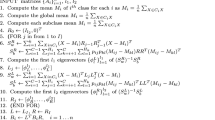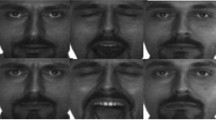Abstract
For high-dimensional classification tasks such as face recognition, the number of samples is smaller than the dimensionality of the samples. In such cases, a problem encountered in Linear Discriminant Analysis-based (LDA) methods for dimension reduction is what is known as the Small Sample Size (SSS) problem. Recently, a number of approaches that attempt to solve the SSS problem have been proposed in the literature. In this paper, a different way of solving the SSS problem compared to these is proposed. It is one that employs a dissimilarity representation method where an object is represented based on the dissimilarity measures among representatives extracted from training samples instead of from the feature vector itself. Thus, by appropriately selecting representatives and by defining the dissimilarity measure, it is possible to reduce the dimensionality and achieve a better classification performance in terms of both speed and accuracy. Apart from utilizing the dissimilarity representation, in this paper simultaneously employing a fusion technique is also proposed in order to increase the classification accuracy. The rationale for this is explained in the paper. The proposed scheme is completely different from the conventional ones in terms of the computation of the transformation matrix, as well as in controlling the number of dimensions. The present experimental results, which to the best of the authors’ knowledge, are the first such reported results, demonstrate that the proposed mechanism achieves nearly identical efficiency results in terms of the classification accuracy compared with the conventional LDA-extension approaches for well-known face databases involving AT&T and Yale databases.
This work was generously supported by the Korea Research Foundation Grant funded by the Korea Government (MOEHRD-KRF-2005-042-D00265).
Preview
Unable to display preview. Download preview PDF.
Similar content being viewed by others
References
Zhou, W., Chellappa, R., Rosenfeld, A., Phillips, P.J.: Face recognition: a literature survey. ACM Compt. Surveys 35(4), 399–458 (2003)
Ruiz-del-Solar, J., Navarrete, P.: Eigenspace-based face recognition: a comparative study of different approaches. IEEE Trans. Systems, Man, and Cybernetics - Part C SMC-35(3), 315–325 (2005)
Belhumeour, P.N., Hespanha, J.P., Kriegman, D.J.: Eigenfaces vs. Fisherfaces: Recognition using class specific linear projection. IEEE Trans. Pattern Anal. and Machine Intell. PAMI-19(7), 711–720 (1997)
Raudys, S., Duin, R.P.W.: On expected classification error of the Fisher linear classifier with pseudoinverse covariance matrix. Pattern Recognition Letters 19, 385–392 (1998)
Yu, H., Yang, J.: A direct LDA algorithm for high-dimensional data - with application to face recognition. Pattern Recognition 34, 2067–2070 (2001)
Lu, J., Plataniotis, K.N., Venetsanopoulos, A.N.: Face recognition using LDA-based algorithm. IEEE Trans. Neural Netw. 14(1), 195–200 (2003)
Yang, J., Zhang, D., Yang, J.-Y.: A generalized K-L expansion method which can deal with small sample size and high-dimensional problems. Pattern Analysis and Applications 6, 47–54 (2003)
Friedman, J.H.: Regularized discriminant analysis. J. Am. Statistical Assoc. 84(405), 165–175 (1989)
Dai, D.Q., Yuen, P.C.: Regularized discriminant analysis and its application to face recognition. Pattern Recognition 36, 845–847 (2003)
Chen, L.-F., Liao, H.-Y.M., Ko, M.-T., Lin, J.-C., Yu, G.-J.: A new LDA-based face reognition system which can be solve the small sample size problem. Pattern Recognition 33, 1713–1726 (2000)
Howland, P., Wang, J., Park, H.: Solving the small sample size problem in face reognition using generalized discriminant analysis. Pattern Recognition 39, 277–287 (2006)
Ye, J., Li, Q.: A two-stage linear discriminant analysis via QR-decomposition. IEEE Trans. Pattern Anal. and Machine Intell. PAMI-27(6), 929–941 (2005)
Cevikalp, H., Neamtu, M., Wilkes, M., Barkana, A.: Discriminative common vectors for face recognition. IEEE Trans. Pattern Anal. and Machine Intell. PAMI-27(1), 4–13 (2005)
Duin, R.P.W., Ridder, D., Tax, D.M.J.: Experiments with a featureless approach to pattern recognition. Pattern Recognition Letters 18, 1159–1166 (1997)
Duin, R.P.W., Pekalska, E., de Ridder, D.: Relational discriminant analysis. Pattern Recognition Letters 20, 1175–1181 (1999)
Pekalska, E., Duin, R.P.W.: Dissimilarity representations allow for buiilding good classifiers. Pattern Recognition Letters 23, 943–956 (2002)
Pekalska, E.: Dissimilarity representations in pattern recognition. Concepts, theory and applications. Ph.D. thesis, Delft University of Technology, Delft, The Netherlands (2005)
Pekalska, E., Duin, R.P.W., Paclik, P.: Prototype selection for dissimilarity-based classifiers. Pattern Recognition 39, 189–208 (2006)
Duin, R.P.W.: Personal communication
Kittler, J., Hatef, M., Duin, R.P.W., Matas, J.: On combining classifiers. IEEE Trans. Pattern Anal. and Machine Intell. PAMI-20(3), 226–239 (1998)
Kuncheva, L.I., Bezdek, J.C., Duin, R.P.W.: Decision templates for multiple classifier fusion: an experimental comparison. Pattern Recognition 34, 299–414 (2001)
Kuncheva, L.I.: A theoretical study on six classifier fusion strategies. IEEE Trans. Pattern Anal. and Machine Intell. PAMI-24(2), 281–286 (2002)
Kim, S.-W., Oommen, B.J.: On optimizing dissimilarity-based classification using prototype reduction schemes (to appear)
Adini, Y., Moses, Y., Ullman, S.: Face recognition: The problem of compensating for changes in illumination direction. IEEE Trans. Pattern Anal. and Machine Intell. PAMI-19(7), 721–732 (1997)
Author information
Authors and Affiliations
Editor information
Editors and Affiliations
Rights and permissions
Copyright information
© 2006 Springer-Verlag Berlin Heidelberg
About this paper
Cite this paper
Kim, SW. (2006). On Using a Dissimilarity Representation Method to Solve the Small Sample Size Problem for Face Recognition. In: Blanc-Talon, J., Philips, W., Popescu, D., Scheunders, P. (eds) Advanced Concepts for Intelligent Vision Systems. ACIVS 2006. Lecture Notes in Computer Science, vol 4179. Springer, Berlin, Heidelberg. https://doi.org/10.1007/11864349_107
Download citation
DOI: https://doi.org/10.1007/11864349_107
Publisher Name: Springer, Berlin, Heidelberg
Print ISBN: 978-3-540-44630-9
Online ISBN: 978-3-540-44632-3
eBook Packages: Computer ScienceComputer Science (R0)




